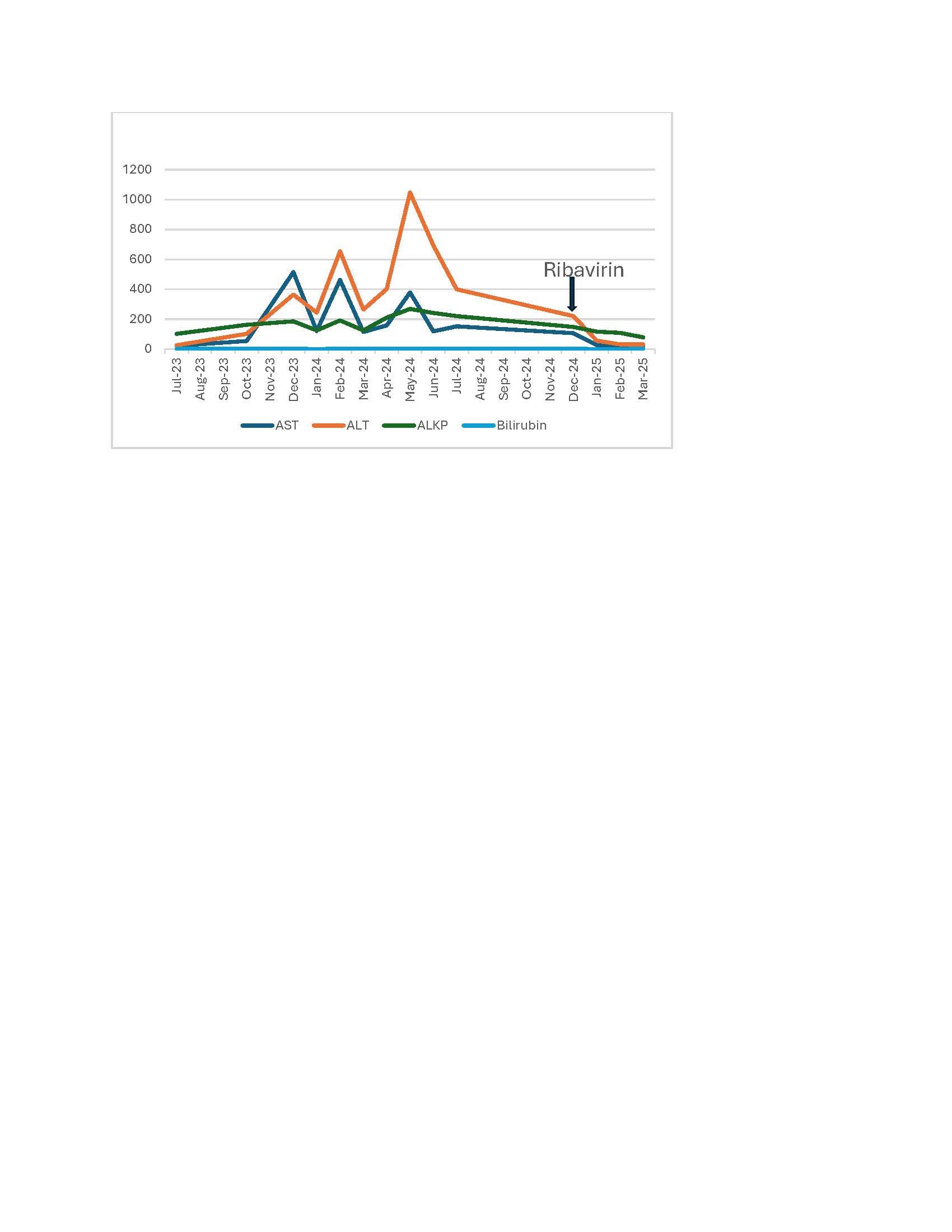Monday Poster Session
Category: Infections and Microbiome
P3480 - Hepatitis E Infection in a Patient With Lymphoma Masquerading as Drug-Induced Liver Injury
Monday, October 27, 2025
10:30 AM - 4:00 PM PDT
Location: Exhibit Hall

Neelakanta A. Atkuri, MD (he/him/his)
Ascension Saint Francis Hospital
Wichita, KS
Presenting Author(s)
Neelakanta A. Atkuri, MD1, Nader Al Souky, MD2, Nassim Nabbout, MD3, Lawrence Zhou, MD2
1Ascension Saint Francis Hospital, Wichita, KS; 2University of Kansas School of Medicine, Wichita, KS; 3Ascension via Christi St.Francis, Wichita, KS
Introduction: Immunocompromised individuals are at high risk for Hepatitis E infection and progression to Cirrhosis and possibly death. Lack of inclusion in routine serology testing often leads to delayed diagnosis.
Case Description/
Methods: A 46-year-old male with a history of hypertension and type 2 diabetes mellitus was diagnosed with diffuse large B-cell lymphoma and underwent chemotherapy with Rituxan, Potaluzumab, and CHP (Cyclophosphamide, Doxorubicin, and Prednisone). Post-treatment, he experienced worsening liver function tests (LFTs) up to aspartate aminotransferase (AST) 514 U/L and alanine aminotransferase (ALT) 364 U/L. Basic work-up, including standard hepatitis panel, was negative, and the patient did not have an alcohol history. The differential diagnosis included, but was not limited to, drug-induced liver injury and autoimmune hepatitis. Treatment was started with prednisone, which led to marked improvement. However, LFTs worsened again (AST 462 U/L and ALT 654 U/L) following completion of the steroid course, so prednisone was restarted with a plan for a slow taper. Nevertheless, his LFTs continued to worsen (peaking at AST 379 U/L and ALT 1047 U/L), and common infectious etiologies, including EBV, HSV, CMV, and repeat hepatitis panel, came back negative. A liver biopsy reported a possible drug-induced liver injury. Due to continued worsening, further testing, including complete hepatitis serologies, was obtained. Hepatitis E testing returned positive with a PCR of 70,200 IU (negative less than 1800 IU/ml) and positive IgG and IgM antibodies. He was started on Ribavirin treatment for 12 weeks with normalization of his liver function studies.
Discussion: Hepatitis E should be considered a potential risk factor for acute and chronic hepatitis, especially in high-risk populations. It is often misdiagnosed as a drug-induced liver injury. Lack of inclusion in routine testing and lack of available labs capable of testing can often lead to a delay in diagnosis and treatment.

Figure: Liver Function Panel Trend
Disclosures:
Neelakanta Atkuri indicated no relevant financial relationships.
Nader Al Souky indicated no relevant financial relationships.
Nassim Nabbout indicated no relevant financial relationships.
Lawrence Zhou indicated no relevant financial relationships.
Neelakanta A. Atkuri, MD1, Nader Al Souky, MD2, Nassim Nabbout, MD3, Lawrence Zhou, MD2. P3480 - Hepatitis E Infection in a Patient With Lymphoma Masquerading as Drug-Induced Liver Injury, ACG 2025 Annual Scientific Meeting Abstracts. Phoenix, AZ: American College of Gastroenterology.
1Ascension Saint Francis Hospital, Wichita, KS; 2University of Kansas School of Medicine, Wichita, KS; 3Ascension via Christi St.Francis, Wichita, KS
Introduction: Immunocompromised individuals are at high risk for Hepatitis E infection and progression to Cirrhosis and possibly death. Lack of inclusion in routine serology testing often leads to delayed diagnosis.
Case Description/
Methods: A 46-year-old male with a history of hypertension and type 2 diabetes mellitus was diagnosed with diffuse large B-cell lymphoma and underwent chemotherapy with Rituxan, Potaluzumab, and CHP (Cyclophosphamide, Doxorubicin, and Prednisone). Post-treatment, he experienced worsening liver function tests (LFTs) up to aspartate aminotransferase (AST) 514 U/L and alanine aminotransferase (ALT) 364 U/L. Basic work-up, including standard hepatitis panel, was negative, and the patient did not have an alcohol history. The differential diagnosis included, but was not limited to, drug-induced liver injury and autoimmune hepatitis. Treatment was started with prednisone, which led to marked improvement. However, LFTs worsened again (AST 462 U/L and ALT 654 U/L) following completion of the steroid course, so prednisone was restarted with a plan for a slow taper. Nevertheless, his LFTs continued to worsen (peaking at AST 379 U/L and ALT 1047 U/L), and common infectious etiologies, including EBV, HSV, CMV, and repeat hepatitis panel, came back negative. A liver biopsy reported a possible drug-induced liver injury. Due to continued worsening, further testing, including complete hepatitis serologies, was obtained. Hepatitis E testing returned positive with a PCR of 70,200 IU (negative less than 1800 IU/ml) and positive IgG and IgM antibodies. He was started on Ribavirin treatment for 12 weeks with normalization of his liver function studies.
Discussion: Hepatitis E should be considered a potential risk factor for acute and chronic hepatitis, especially in high-risk populations. It is often misdiagnosed as a drug-induced liver injury. Lack of inclusion in routine testing and lack of available labs capable of testing can often lead to a delay in diagnosis and treatment.

Figure: Liver Function Panel Trend
Disclosures:
Neelakanta Atkuri indicated no relevant financial relationships.
Nader Al Souky indicated no relevant financial relationships.
Nassim Nabbout indicated no relevant financial relationships.
Lawrence Zhou indicated no relevant financial relationships.
Neelakanta A. Atkuri, MD1, Nader Al Souky, MD2, Nassim Nabbout, MD3, Lawrence Zhou, MD2. P3480 - Hepatitis E Infection in a Patient With Lymphoma Masquerading as Drug-Induced Liver Injury, ACG 2025 Annual Scientific Meeting Abstracts. Phoenix, AZ: American College of Gastroenterology.
